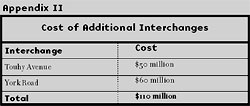Making the Case for Public-Private Partnerships in Illinois
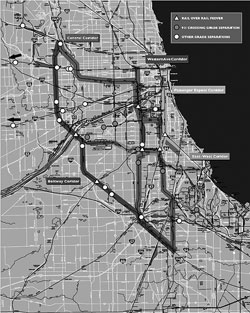
Business Leaders for Transportation’s new report, “Making the Case for Public-Private Partnerships in Illinois.”
PUBLIC PRIVATE PARTNERSHIP COMMITTEE
Chair
John Gates
Former Board Chair, Metropolitan Planning Council
Members MarySue Barrett
President, Metropolitan Planning Council
Frank H. Beal
Executive Director, Chicago Metropolis 2020
Bernard J. Ford
Sr. Chair, Chicagoland Chamber of Commerce Transportation Infrastructure Committee
Kit Hodge
Associate, Metropolitan Planning Council
James C. LaBelle
Deputy Director, Chicago Metropolis 2020
Thomas H. Morsch
Co-Chair, Metropolitan Planning Council Transportation Committee
Rob Nash
Director of Government Relations, Chicagoland Chamber of Commerce
Gerald J. Roper
President and CEO, Chicagoland Chamber of Commerce
Peter Skosey
Vice President of External Relations, Metropolitan Planning Council
Maria Choca
Urban Program Director, Chicago Metropolis 2020
Executive Summary To keep the Chicago area competitive, our rails, roads and airways need regular investment in their maintenance and sensible expansion. However, without money to nourish the system, the whole region weakens. Recent passage of federal legislation to finance transportation improvements in Illinois and around the country provides a much needed funding infusion. But even with the new federal dollars, the state and northeastern Illinois still lack the money to complete critical transportation improvements.
Given our troubled budget climate, Business Leaders for Transportation urges the State of Illinois to use Public-Private Partnerships aggressively to build and maintain vital transportation infrastructure. Specifically, we recommend that, in the 2006 legislative session, the state adopt legislation that would enable Partnerships to play a strong role in transportation investments. Chicago’s Skyway transaction and numerous other national and international projects have shown that Public-Private Partnerships are a sound method for building and maintaining vital transportation infrastructure. Creative use of private capital can minimize the need for governments to raise new revenue and take on new debt, thus freeing up limited resources for other priorities.
To illustrate their viability, Business Leaders for Transportation conducted an evaluation of Public-Private Partnerships using the proposed Elgin-O’Hare Extension/O’Hare Bypass project as a case study. Our preliminary analysis demonstrates that a Public-Private Partnership for this project could generate sufficient toll revenues to attract private investors at a level that would finally make the long-desired project achievable.
Since the late 19th century, railroads, waterways, public transit, and roads have helped catalyze economic growth in our region. Ongoing investment in critical transportation infrastructure has been essential to metropolitan Chicago’s emergence and continued status as a leader in the national economy and as a global transportation hub. To make the region work and maintain our position as a global commerce center and tourism destination, we must be prepared to invest in the transportation systems that have made us so successful.
The Fiscal Crunch The combination of current funding methods is not sufficient to fully maintain the existing transportation system, let alone keep pace with increased demands. Money is scarcer at every level of government, and critical sources of transportation funds are not keeping pace with needs.
State motor fuel taxes have not matched inflation, and have lagged increased highway use by 20 percent since 1990. Overall, state and local governments have increased their reliance on general sales, income and property taxes to fund transportation, because the traditional sources of funding are not keeping up with demand.
The State of Illinois has not dedicated funds to invest in infrastructure since Illinois FIRST expired in 2004. Approved by the governor and General Assembly in 1999, Illinois FIRST dedicated funds over five years to update infrastructure, including $6 billion for railways and roads. This commitment helped secure federal transportation funding that would have been unavailable without the state matching funds. As impressive as Illinois FIRST was, by June 2004, the funds were exhausted, and the state has limped along without a capital funding program for the past two years. Without a new source of revenue, the state does not have sufficient funds to maintain the existing system, much less pay for needed new service or match funding that Congress has authorized for many new projects.
The Safe, Accountable, Flexible, and Efficient Transportation Equity Act: A Legacy for Users (SAFETEA-LU), passed by Congress last summer, included substantial increases in federal funding for Illinois public transportation, roads and bridges through 2009. Federal funding certainly helps, but it will not be enough to meet all of the region’s transportation needs. In addition to providing general funding to maintain and rebuild roads and transit, SAFETEA-LU “earmarked” funding for a large number of specific projects. But SAFETEA-LU money is no guarantee that projects will ever be built. In many cases, projects authorized in SAFETEA-LU include no construction funding or only a small portion of the total project cost, leaving the state and local governments to raise funds to complete them.
In short, the Chicago region currently has insufficient state, federal and local funding to complete needed transportation system improvements, expand service, or launch federally authorized projects. New funding sources must be developed to guarantee a long-term, viable solution to funding our infrastructure needs.
Federal Funding: Just a Small Piece of Pie Illinois’ congressional delegation was able to secure dedicated funding for a number of significant projects in the most recent federal transportation bill, but there is no guarantee that they will be built because state and regional agencies do not have the funds to complete them. In many cases, projects authorized in SAFETEA-LU include no construction funding or only a small portion of the total project cost, leaving the state and local governments to raise funds to complete them.
Examples
- $100 million for the Chicago Regional Environmental and Transportation Efficiency plan (CREATE) to improve road and commuter rail networks by decreasing freight rail bottlenecks in northeastern Illinois Projected cost $1.5 billion

- $25 million for the completion of the Wacker Drive Reconstruction Project Projected cost $350 million
- $140 million for the Elgin-O’Hare Extension/O’Hare Bypass, which includes extending the current Elgin-O’Hare Expressway east of I-290 to O’Hare Airport, and creating a new toll road connecting the western side of O’Hare with I-90 to the north, I-294 to the south, and I-290 to the west Projected cost $1.345 billion
An Innovative Solution Public-Private Partnerships can fill the funding gap. Given the tremendous capital shortfall in addressing the future development and maintenance of our transportation infrastructure, the State of Illinois must actively pursue innovative funding solutions. One such innovative approach, common in Europe, Canada, South America, Asia, and Australia is to create Public-Private Partnerships. Partnerships can take many forms. Sometimes, they involve attracting private sector capital, raised in the debt and equity marketplace, to replace or fill the gap left by public funding shortfalls. Partnerships can also take the form of long-term operating and maintenance contracts that transfer risks and costs to the private sector. Many types of infrastructure assets have been funded utilizing the Partnership concept, both new projects and upgrades or enhancements to existing infrastructure.
Mayor Richard M. Daley and the Chicago City Council implemented the first Partnership of its kind in the United States by leasing the Chicago Skyway to a private company for 99 years. This transaction provided $1.83 billion for the City of Chicago, and has spurred the consideration of similar proposals in Indiana, Delaware, and many other states. But Illinois remains hindered by its failure to pass legislation enabling Public-Private Partnerships, even though other states are rapidly adopting such legislation.
Aside from the successful Chicago Skyway agreement, Public-Private Partnerships have successfully financed numerous infrastructure improvements around the world. In Italy and Australia, the majority of toll roads are owned by the private sector. 1 The public, government and private sectors support Partnerships in those countries because they serve everyone’s interests. By combining resources and incentives and sharing risks between the public and private sectors, the public’s needs can be served while a large portion of the costs are absorbed by the private market.
Legislation Needed The U.S. Dept. of Transportation has recently taken administrative action that will make it easier for states to move forward with Partnerships. States that have approved legislation authorizing Partnerships are now better positioned to take advantage of federal incentives to use Public-Private Partnerships for maintenance and new construction of their infrastructure. As of February 2004, 23 states — not including Illinois — have enacted legislation that would allow Partnerships to be used for transportation infrastructure. 2 As a result, the list of Public-Private Partnership projects in other states is growing, and includes projects like Minnesota’s Hiawatha Light Rail, Colorado’s E-470 Tollway, New Jersey’s Hudson-Bergen Light Rail, Nevada’s Las Vegas Light Rail, Massachusetts Route 3 North, Virginia’s Dulles Greenway and Pocahontas Parkway, California’s SR 125, and Alabama’s Folly Beach Express.
Business Leaders for Transportation urges Illinois to move forward aggressively by adopting legislation authorizing Partnerships to play a role in transportation investments. Public-Private Partnerships are a sound method for building and maintaining vital transportation infrastructure while minimizing the need for additional public revenue, lessening the need for new hefty debt, and freeing up limited resources for other priorities. Public-Private Partnerships can help deliver the quality multi-modal transportation infrastructure that the public needs despite current funding challenges. Business Leaders for Transportation looks forward to the valuable impacts Partnerships will have on the future of Illinois’ transportation network.
Footnote
www.heritage.org/Research/SmartGrowth/tst060704a.cfm
2 U.S. Department of Transportation Federal Highway Administration, 2005. Retrieved February, 2005, from www.fhwa.dot.gov/Partnership/legislation.htm
CASE STUDY: ELGIN-O’HARE EXTENSION/O’HARE BYPASS AS A PUBLIC PRIVATE
To illustrate the potential of a Public-Private Partnership to finance transportation improvements in Illinois, Business Leaders for Transportation has analyzed the feasibility of attracting private sector funding to accelerate the construction of the Elgin-O’Hare Extension/O’Hare Bypass project.
The expressway — included in the long-range plans of the Chicago Area Transportation Study, Northeastern Illinois Planning Commission, DuPage County, Chicago Metropolis 2020, O’Hare Modernization Plan, and other planning bodies for many years — would extend the current Elgin-O’Hare Expressway east of I-290 to O’Hare Airport and create a new toll road connecting the western side of O’Hare with I-90 to the north, I-294 to the south, and I-290 to the west.
In 2004, the Illinois State Toll Highway Authority approved a 10-year, $5.3 billion capital plan that commits $139 million to fund a portion of the cost to construct the O’Hare Bypass piece of the project. Congress has helped by earmarking $140 million in federal funding for the project as part of SAFETEA-LU.
A PUBLIC-PRIVATE PARTNERSHIP FOR THE ELGIN-O’HARE BYPASS – THE SENSIBLE SOLUTION
Give people what they want The Elgin-O’Hare Extension/O’Hare Bypass has been widely supported for many years due to its more direct connection to O’Hare and beyond, as well as its potential to improve freight movement and support business development around the airport.
Create jobs and expand the local economy The construction, maintenance and management of the road will create both temporary and permanent jobs for Illinois residents. It will also expand travel choices, improve freight movement, and create new opportunities for business investment.
We can’t build it any other way Though the expressway has been on the region’s wish list for many years, Illinois hasn’t been able to afford to build it using public money or current tolls. We’re unlikely to be able to afford it in the foreseeable future without the use of a Public-Private Partnership.
Given the relative consensus among political leaders and the great amount of study the project has received from the Ill. Dept. of Transportation (IDOT), Illinois Toll Highway Authority, and others, detailed engineering and construction of the expressway could move forward quickly after the state secures full funding. IDOT has secured most of the land right-of-way for the Elgin-O’Hare Extension. At this point, the major impediment to breaking ground is the lack of adequate funding for this $1.345 billion project.
The lack of adequate funding has become especially problematic in the last few months as plans for the expansion of O’Hare Airport have moved rapidly forward, albeit with a noticeable lack of clarity around western access. Transportation infrastructure west of O’Hare is a key part of modernizing the airport. It is expected that once the modernization program begins in earnest, even more businesses that depend upon access and proximity to the airport will locate to the west. The development of a transportation link will provide the backbone for significant economic growth that will occur around O’Hare and benefit all of northeastern Illinois.
Business Leaders for Transportation compiled and analyzed several critical variables to assess the feasibility of attracting private sector debt and equity to fund the Elgin-O’Hare Extension/O’Hare Bypass: construction cost of the project, status of environmental approvals, expected duration of the construction, commercial and passenger vehicle traffic expected to use the new highway, and potential revenue generated from tolls. Using these data, the study team developed a range of private capital that could be attracted based on similar projects.
Business Leaders researched and updated the projected construction cost of the various expressway options (Table 1). In addition, the coalition retained the firm of Vollmer Associates LLP to project traffic counts and associated revenues assuming several toll options (Table 2). This analysis, assumes the mid range toll rate of $.80 I-PASS and $1.60 cash, lower than the Chicago Skyway. (Though these toll rates are higher than current adjacent toll road rates, by 2011 — when the roads would first open — these rates are expected to be consistent with rates on the rest of the Illinois’ toll roads.) Finally, industry benchmarks were used to determine the amount of private debt and equity a Partnership would command on the market (Table 3).
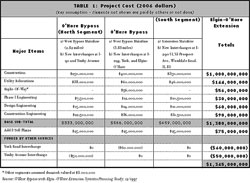
Key assumptions in the Business Leaders study included the following:
- Construction Cost: $1.345 billion
Traffic planners have well-documented cost estimates for the expressway in numerous reports associated with the O’Hare Modernization Project, IDOT, and the Illinois Tollway Highway Authority. Assuming tolls will be a necessary component, the cost for toll plazas was added to these estimates. All but $56 million of the right-of-way bulk of which is publicly owned, is assumed donated. The total estimated project cost in 2006 dollars is $1.345 billion. - Toll Revenue Projection: $148 million per year by 2030
Once the expressway opens to drivers, assuming five years of construction, daily traffic volumes would top 65,800 cars. This traffic estimate means that, with a toll of $.80 I-PASS and $1.60 cash per car, the expressway would generate over $33 million in its first year. (Again, these toll estimates are higher than current toll road rates, but are expected to be in line with Illinois toll road rates in 2011, when the roads would open.) Revenue will steadily climb as traffic volumes increase along with regional population and economic development growth, and as toll rates increase based on the Consumer Price Index (see Table 2 for toll estimates and Appendix I for traffic assumptions). In five years, the traffic volume is expected to increase to more than 132,000 cars per day, generating $71.05 million in revenue; by 2030, traffic volume is expected to increase to over 194,000 cars per day, yielding $148 million.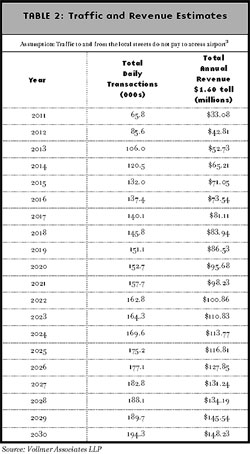
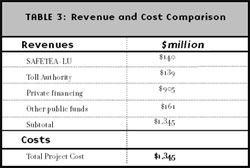
- Estimate of Potential Private Capital: $905 million
In late 2004, the Chicago Skyway transaction attracted $1.8 billion from the private debt and equity markets. Several months ago, the new owners of the Skyway refinanced and raised $1.1 billion from global debt markets. While these figures may be higher than what could be attracted given the additional construction risks of the “greenfield” Elgin-O’Hare Extension/O’Hare Bypass, they do serve as a reliable benchmark given the remarkably similar revenue-generating capability of the Skyway and the expressway. Using other recent Public-Private Partnership transactions of similar roadways in the U.S. and Canada, Business Leaders conservatively estimates the Elgin-O’Hare Extension/O’Hare Bypass has the potential to generate an estimated $905 million in private equity. Factoring in $140 million from the federal transportation bill and $139 million from the Toll Highway Authority, and excluding potential revenue from ancillary sources (concessions, marketing, etc.), this analysis concludes that a $161 million gap might exist to be filled by other public funds (Table 3). Funding for interchanges, including the York Road and Touhy Avenue interchanges, would also come from other public and private sources. (See appendix II.)
Conclusions Business Leaders for Transportation’s analysis of the feasibility of using a Public-Private Partnership to finance the construction and maintenance of the Elgin-O’Hare Extension/ O’Hare Bypass shows that it would be a cost-effective and expedient way to build the road. Without the added benefit of the private dollars, Illinois would have to contribute $905 million more to build the project and millions more to maintain it in the future. These precious capital dollars could be used as a match for other needed improvements in the state such as those already receiving federal funding through SAFETEA-LU.
The Chicago region should build on its experience with Public-Private Partnerships and look to this innovative structure to help fill the gap in the state’s infrastructure funding. Business Leaders analysis of the expressway shows that Partnerships can add substantially to the available financing for vital transportation infrastructure and would help fulfill a critical and timely infrastructure need. The Illinois state legislature should immediately enact legislation making it possible to use public private partnerships to build qualified projects like the Elgin-O’Hare Extension/O’Hare Bypass.
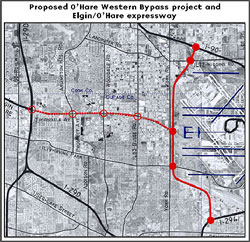
Appendix I Traffic and Revenue Model Assumptions Growth Rates
- Background 1.3%
- Congestion Driven (2% additional)
- Toll Inflation Factor (1% additional)
- Elgin-O’Hare Extension/O’Hare Bypass
- For 120,000 vehicles per day (VPD) to 150,000 VPD, reduce congestion driven growth by 1%
- Over 150,000 VPD, reduce growth to background growth only
- Cap volume at 170,000 VPD
- Roadways feeding Elgin-O’Hare Extension/O’Hare Bypass
- No constraints on I-294 – traffic diverted from I-290 will be able to use I-294 for access
- No constraints on I-90 to the north where bypass connects
- All ramps to and from the proposed roadway will have sufficient capacity
- All traffic pays toll to enter the western terminal
- 33% reduction in traffic for doubling of toll
- 5 years for road construction
- 3 years for western terminal
- 60% opening day
- Escalate to 80% in 2030
- 3% annual growth rate based on CPI rounded to the nearest nickel
- Tolls increase every 3 years
